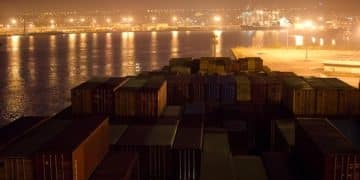Trump’s Border Security Policies: Trade Impacts & Latest Updates

The Trump administration’s policies on border security led to significant changes impacting trade relations, including increased enforcement, construction of a border wall, and shifts in immigration policies, all of which influenced trade dynamics with countries like Mexico and Canada.
The Trump administration’s policies on border security: What are the latest developments and their impact on trade? This question has become increasingly relevant in recent years, as changes in border enforcement and immigration policies have had a ripple effect on international trade. Let’s examine the specifics of these policies and their consequences.
Overview of Trump’s Border Security Measures
During his time in office, President Trump implemented a series of border security measures aimed at curbing illegal immigration and enhancing national security. These policies included the construction of a border wall, increased enforcement at ports of entry, and changes to asylum procedures. These initiatives were intended to secure the border and reduce the flow of undocumented immigrants into the country.
Key border security policies
Several key policies defined the Trump administration’s approach to border security. Let’s break down some of the most significant:
- Border Wall Construction: A central promise of Trump’s campaign was the construction of a wall along the US-Mexico border. The administration allocated significant resources to this project, aiming to create a physical barrier to deter illegal crossings.
- Increased Enforcement: The Department of Homeland Security (DHS) significantly increased the number of border patrol agents and enhanced technological surveillance capabilities. This led to a rise in apprehensions and deportations.
- “Remain in Mexico” Policy: Officially known as the Migrant Protection Protocols (MPP), this policy required asylum seekers to remain in Mexico while their US immigration cases were processed.
These policies reflected a broader strategy focused on deterring illegal immigration through stricter enforcement and physical barriers.

Impact on US-Mexico Trade Relations
The Trump administration’s border security policies strained trade relations between the United States and Mexico. Increased border enforcement and rhetoric created uncertainty and disruptions in cross-border trade. Mexico, a key trading partner of the US, faced heightened security measures that affected the flow of goods and people.
Economic Challenges
The impact on trade relations created several economic challenges for both countries. Here are some key areas affected:
- Supply Chain Disruptions: Increased inspections and security measures at the border led to delays in the movement of goods, impacting supply chains and increasing costs for businesses.
- Increased Trade Costs: The added security infrastructure and personnel resulted in higher operational costs for companies engaged in cross-border trade.
- Reduced Trade Volume: Uncertainty and stricter enforcement contributed to a decrease in overall trade volume between the US and Mexico in certain sectors.
These challenges underscored the complex relationship between border security and international trade, highlighting the need for balanced policies.
The “Remain in Mexico” Policy and Its Implications
The “Remain in Mexico” policy, or Migrant Protection Protocols (MPP), had significant implications for asylum seekers and border communities. Under this policy, asylum seekers were required to wait in Mexico while their cases were processed in the US, often facing difficult and unsafe conditions.
Implications for Asylum Seekers
The “Remain in Mexico” policy created significant hardships for asylum seekers. These included:
- Increased Vulnerability: Asylum seekers were exposed to violence, extortion, and exploitation while waiting in Mexican border towns.
- Limited Access to Legal Assistance: Access to legal representation and resources was significantly limited for those waiting in Mexico.
- Humanitarian Crisis: The policy contributed to a humanitarian crisis along the border, with overcrowded shelters and inadequate resources.
These issues raised serious concerns about human rights and the treatment of vulnerable populations.

Trade Diversion and Alternative Markets
In response to the Trump administration’s policies, some businesses explored trade diversion strategies and alternative markets. Trade diversion involves shifting trade flows away from one country and toward another. This can occur when tariffs or other trade barriers make it less attractive to trade with a particular nation.
Alternative markets became more appealing as businesses sought to mitigate the risks associated with US border policies. This was particularly true for companies that relied on smooth and predictable trade flows with Mexico.
Looking at trade diversion
Here are a few elements of trade diversion and how they relate to the Trump adminitration’s policies.
- Seeking New Partners: Companies looked to diversify their supply chains by seeking new trading partners in other regions, such as Asia and Europe.
- Internal Adjustments: Some businesses shifted production or sourcing away from Mexico to avoid border-related disruptions.
- Regional Agreements: Countries explored new regional trade agreements to reduce reliance on the US market.
By diversifying trade relationships, businesses aimed to reduce their vulnerability to policy changes and disruptions in any single market.
Economic Impact on Border Communities
Border communities in the United States experienced varying economic impacts as a result of the Trump administration’s border security policies. These communities, which rely heavily on cross-border trade and tourism, faced both challenges and opportunities.
Increased border enforcement and security measures affected local economies in several ways.
What effect did this have
Here is a brief rundown of the effects on the community.:
- Decreased Tourism: Heightened security and negative rhetoric deterred some tourists from visiting border areas.
- Job Creation: Increased border patrol staffing and infrastructure projects led to some job creation in law enforcement and construction.
- Strained Resources: Border communities faced increased strain on social services and resources due to an influx of migrants and asylum seekers.
The overall economic impact on border communities was multifaceted and often depended on the specific location and industry.
Recent Developments and Policy Adjustments
Following the Trump administration, there have been some adjustments to border security policies. The Biden administration has taken steps to roll back certain measures and implement new approaches to border management. These adjustments aim to balance security with humanitarian concerns and address the root causes of migration.
Here’s a closer look at recent developments and policy adjustments:
- End of “Remain in Mexico”: In August 2022, the official end of the “Remain in Mexico” program came, although the number of those impacted by it is still not fully known.
- Increased Humanitarian Aid: Efforts have been made to provide more humanitarian assistance to migrants and asylum seekers at the border.
- Focus on Root Causes: The administration has emphasized addressing the underlying factors that drive migration, such as poverty, violence, and instability in Central America.
These policy changes reflect a shift toward a more comprehensive and humane approach to border management.
| Key Point | Brief Description |
|---|---|
| 🚧 Border Wall Construction | Building a physical barrier to deter illegal crossings. |
| 🛂 “Remain in Mexico” Policy | Asylum seekers wait in Mexico during US case processing. |
| 📉 Trade Volume Reduction | Uncertainty led to lower US-Mexico trade volumes. |
| 🔄 Policy Adjustments | Efforts to balance security with humane approaches. |
FAQ Section
▼
The primary goal was to curb illegal immigration and enhance national security through increased enforcement, physical barriers, and stricter asylum procedures.
▼
It forced asylum seekers to wait in Mexico while their US cases were processed, exposing them to violence, limited resources, and legal assistance.
▼
The effects included supply chain disruptions, increased trade costs, and reduced trade volume due to heightened security and uncertainty.
▼
Border communities experienced decreased tourism, potential job creation in law enforcement and construction, and strained resources due to migrant influx.
▼
Adjustments involved ending “Remain in Mexico”, increasing humanitarian aid, and addressing the root causes of migration to balance security with concerns.
Conclusion
The Trump administration’s border security policies brought significant shifts in US immigration and trade dynamics. While aiming to enhance national security, these policies strained trade relations and created humanitarian challenges, leading to recent adjustments that seek a more balanced approach to border management and international cooperation.





